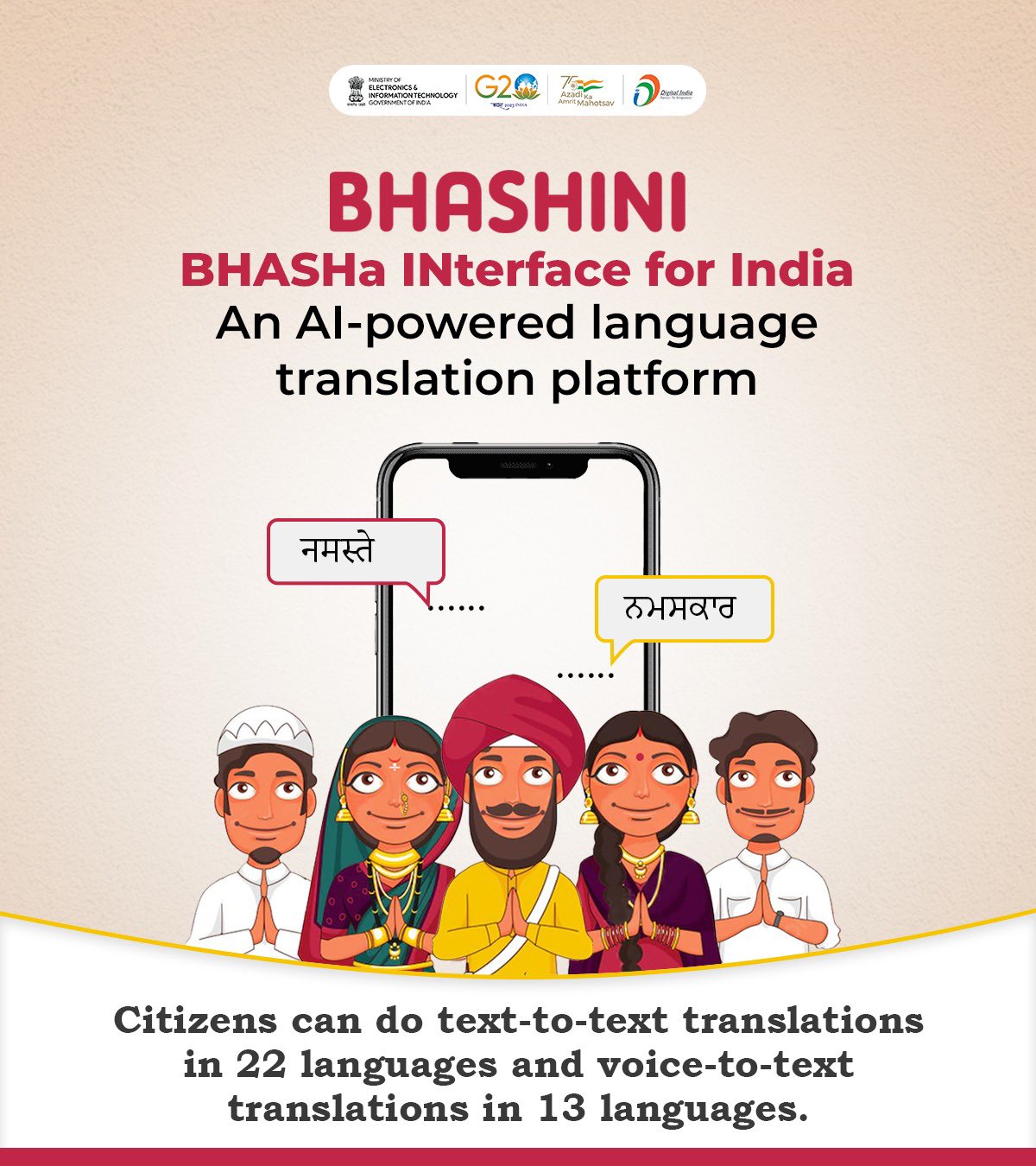More Coverage
Twitter Coverage
Satyaagrah
Written on
Satyaagrah
Written on
Satyaagrah
Written on
Satyaagrah
Written on
Satyaagrah
Written on
JOIN SATYAAGRAH SOCIAL MEDIA
"India speaks, Bhashini translates": 'Bhashini', India's AI breakthrough, revolutionizes linguistic inclusivity, and ensuring no citizen is left behind in the digital realm, a beacon for tech innovation, redefining the nation's digital journey

The rise of Artificial Intelligence (AI) has undeniably revolutionized the way we interact with technology. Yet, in a nation as linguistically diverse as India, there's a pressing need to ensure that AI technology speaks the language of every citizen, not just a select few. Enter 'Bhashini', the government's ambitious project geared to bridge the linguistic divide in India's vast digital landscape.
|
Recently, the Indian government has shown a renewed commitment to supporting indigenous alternatives to global tech giants. Bhashini, a locally conceived platform, has now been spotlighted as an alternative to Google’s language translation services. The announcement of its inclusion in the government's expansive Digital India initiative, bolstered by a whopping budget of Rs 14,903 crore, further underscores its significance.
Pioneering as an 'AI-enabled' multi-language translation tool, Bhashini currently extends support to 10 major Indian languages. With the government's patronage, there's much optimism that the platform will soon encompass all 22 official Indian languages. This endeavor seamlessly aligns with the government's expansive National Language Translation Mission.
At its core, Bhashini is more than just a translation tool; it's a mission. A mission that envisions breaking down the linguistic barriers that exist amongst the myriad Indian languages. By harnessing the power of AI and Natural Language Processing (NLP), it aims to democratize these resources, making them accessible in the public domain. Target audiences like Indian MSMEs, startups, and individual innovators stand to gain immensely. Such resources pave the way for developers to provide every Indian easy access to the internet and digital services in their mother tongue. In an insightful chat on BTTV, Shakshi engaged with Amitabh Nag, CEO, Bhashini Division, Digital India, shedding light on the platform's potential and its larger role in India's digital story.
India's linguistic tapestry is intricate, boasting a staggering 19,500 languages and dialects. Yet, it's a sobering fact that only 10% of the population are fluent English speakers. While Hindi, spoken by 43.63% of Indians, remains dominant, a vast section of the populace communicates in various native languages. The mission to democratize AI in India hinges on ensuring accessibility in these native languages.
In the intricate tapestry of India's linguistic diversity, Bhashini emerges as a bright thread, binding the nation closer through the power of AI. Designed to overcome language barriers, Bhashini is more than just a tool; it's a beacon of hope for countless Indians who have, for long, been on the fringes of the digital revolution due to linguistic limitations.
While the prowess of large language models (LLMs), such as the GPT models by OpenAI, is undeniable in the realm of English, there remains an expansive void in catering to the rich variety of Indian languages. Bhashini, in essence, steps up to fill this gap. ChatGPT, riding on the strength of its 100 million global users, including a significant fraction from India, marked the beginning of AI's reach. But it's Bhashini's deep dive into the ocean of Indic languages that signifies the dawn of a truly democratic AI ecosystem in India.
The G20 stage and PM Modi's Vision
Bhashini's potential didn't just resonate within India's borders. At the G20 Digital Economy Working Group Ministers Meet, PM Narendra Modi spotlighted Bhashini, underscoring India's emerging stature as a hub for technological ingenuity. With pride in his voice, he declared, “We are building ‘Bhashini’, an AI-powered language translation platform. It will support digital inclusion in all the diverse languages of India."
Digging deeper into the government's aspirations for a digitalized India, the focus isn't limited to Bhashini alone. A sweeping vision unfolds, encompassing the modernization of the National Knowledge Network (NKN), an impressive matrix connecting 1,787 educational establishments. Furthermore, in a world increasingly threatened by cyber vulnerabilities, the government is prioritizing cybersecurity education, with plans to roll out cyber-awareness modules for a staggering 12 crore college students.
A Unified Approach to a Linguistic Renaissance | Currently, Bhashini's architects are working tirelessly to shape a "unifying architecture". The mission? To cultivate a thriving community of contributors who approach the project with synchronized dedication. Beyond mere translations, Bhashini's horizon is expansive. The platform is poised to open its doors for individuals, inviting them to contribute local linguistic nuances. These invaluable submissions are more than just data points; they are the building blocks that will refine and elevate the service to unparalleled heights.
Bhashini's Multifaceted Applications
India's technological marvel, Bhashini, has swiftly transcended from being a mere conceptual framework to a pivotal tool driving digital inclusion across sectors. Unveiled by Prime Minister Narendra Modi in 2022, its real-world applications are burgeoning, underscoring its versatile potential.
The Railways Connection | Highlighting its growing significance, the Indian Railway Catering and Tourism Corporation (IRCTC) has incorporated Bhashini into its chatbot, AskDISHA. The past narrative was limited; passengers conversed with the bot in English, Hindi, or the colloquial 'Hinglish'. But with Bhashini's integration, a broader linguistic canvas is painted. Ankush Sabharwal, the visionary behind CoRover.ai, the firm that engineered AskDISHA, shared that the chatbot now effortlessly interacts in Gujarati. And this is just the beginning - there's a roadmap to include around 10 additional languages, expanding the horizons of AI-driven e-ticketing.
Empowering Maharashtra's Farmers | Bhashini's resonance is felt even in the agrarian corridors of Maharashtra. Ajay Singh Rajawat, a spearhead at the Bhashini division under the Ministry of Electronics and Information Technology (MeitY), cited its use by the Nanaji Deshmukh Krishi Sanjivani Prakalp (PoCRA). An initiative helmed by Maharashtra's Department of Agriculture, PoCRA employs Bhashini to bridge the language gap for farmers. With its help, they now access vital schemes, documents, and programmes tailored in their mother tongue, Marathi, centering on crucial climate resilience support.
|
Revolutionizing Public Grievance Redressal | Come May 2023, the landscape of public grievance redressal will witness a monumental shift. The Department of Administrative Reforms and Public Grievances (DARPG) is infusing Bhashini's prowess into the Centralised Public Grievance Redressal and Monitoring System (CPGRAMS) portal. This integration is transformative. Grievance redressal officers (GROs) can now translate regional grievances into English. Concurrently, the aggrieved citizens receive their responses in both English and their native tongue, as highlighted by the Ministry of Personnel, Public Grievances & Pensions. Such an approach redefines transparent communication, strengthening the bond between the populace and the administrative machinery.
Bridging Language Barriers with Technological Prowess | Bhashini is not just another technological marvel; it's a visionary project anchoring the vast linguistic diversity of India in a cohesive digital framework. This initiative's translation models, IndicTrans and its successor, IndicTrans2, are the result of a collaborative venture with AI4Bharat, a brainchild of IIT Madras. These models have caught the attention of many in the tech realm, most prominently, the KissanAI platform, formerly known as KissanGPT.
Pratik Desai, the ingenious mind behind KissanAI, shared some valuable insights with AIM. "We initially incorporated a self-hosted version of IndicTrans during KissanAI's infancy. The demand surge, combined with models that were yet to be production-ready, pushed us to explore alternative models." However, with Bhashini now offering upgraded API access through IndicTrans2, Desai is enthusiastic about re-integrating it. He further extolled Bhashini's models, emphasizing their tailored optimization for Indic languages. He opined that they surpass many industry standards, including Whisper and Azure, particularly in Indic language translation.
 |
A salient feature of Bhashini is its capability to perform speech translation in 14 distinct languages while facilitating text-to-text translation in all 22 official Indian languages. This becomes pivotal considering India's vast array of governmental schemes and programs. The multitude of criteria, stipulations, and the labyrinth of official websites often pose challenges, especially for those with limited English or Hindi proficiency.
Aravinth Bheemaraj, a prominent engineering leader at Tarento, shared his perspective with AIM. "Bhashini's ethos is rooted in dismantling linguistic barriers across sectors. With it, official governmental documents, reports, and communications can now resonate with the linguistic preferences of the masses."
Ankush Sabharwal echoed a similar sentiment, emphasizing Bhashini's potential in a country where only a fraction speaks English and Hindi is confined to roughly half the populace. "Bhashini's initiative," he said, "is a beacon of inclusivity. By bridging the digital divide through native languages, it ensures that linguistic proficiency doesn't limit one's access to digital platforms and services."
Imagine the transformative power of technology that enables an illiterate farmer in Uttar Pradesh, fluent only in Kannauji, to seamlessly communicate and benefit from government services in his native tongue. This isn't a hypothetical scenario; Bhashini is bringing it to life, and its impact is already palpable.
The Jugalbandi chatbot, an Indian innovation integrated with OpenAI's GPT models and Bhashini's translation prowess, serves as a testament to this. Microsoft narrated a poignant instance of Vandana, an 18-year-old from Biwan, Haryana. Curious about scholarships catering to her field of study, Vandana engaged with Jugalbandi in Hindi. The bot, duly equipped, provided her with an extensive list and articulated the associated eligibility criteria. Abdullah Khan, a farmer hailing from the same village, tapped into Jugalbandi's capabilities to enlighten fellow agrarians about government-sponsored financial aid programs. Thanks to Bhashini's integration, this chatbot caters to 10 out of the 22 official Indian languages, magnifying its reach and impact.
But Bhashini isn’t just limiting its vision to digital accessibility. It's poised to redefine financial inclusivity in India. The Reserve Bank of India (RBI), sensing the potential, is integrating voice commands into the Unified Payments Interface (UPI) by harnessing Bhashini's capabilities. This strategic move will empower users to execute payments through a voice interface in both English and Hindi, with an ambitious plan to incorporate more languages.
|
Despite smartphones being a common sight in rural landscapes, UPI adoption remains tepid, attributed in part to literacy challenges. Through the voice interface, the RBI is not just integrating technology but integrating dreams, hopes, and aspirations, with Bhashini acting as the linchpin in this transformative journey.
In the expanding universe of technology, Bhashini emerges as a shining star, illuminating pathways for businesses and innovators. Sabharwal, echoing the sentiments of many, lauds Bhashini's offering as not just technologically proficient but financially emancipatory. “The beauty of Bhashini lies in its inclusivity; it's an enabler making tech interventions free and universally accessible. The ripple effect is felt by businesses like ours, amplifying our reach and resonance across India," he remarked.
But every innovation, no matter how transformative, invites a discerning eye. The current alternatives in the tech market, though expensive, set a benchmark for precision. Sabharwal, however, remains optimistic about Bhashini’s trajectory. He believes in the power of hyper-localisation. As Bhashini garners more users and navigates through iterative feedback, the precision of its models is bound to leapfrog.
| TRY BHASHINI YOURSELF |
Yet, the vista of possibilities remains expansive. From Sabharwal's vantage point, Bhashini's palette needs more shades - more languages, more dialects, and even foreign tongues, which could be a boon for the burgeoning tourism industry in India. Desai adds another layer to the conversation, suggesting that Bhashini could evolve into a more adaptable tool by allowing firms to fine-tune its models using their datasets. He emphasizes the significance of open-sourced projects, suggesting that Bhashini should take a leaf out of their book: "For Bhashini to truly stand as a beacon of open-source excellence, it needs clear documentation, defined contribution guidelines, and a streamlined framework akin to leading open-source ventures,” he concluded.
In the grand tapestry of technological evolution, Bhashini is not just a stitch; it's a vibrant motif, promising to redefine the contours of digital inclusivity and innovation in India.
The World Bank has commended India's Digital Public Infrastructure (DPI) for its transformative impact, surpassing mere financial inclusion. This international financial institution has praised India's remarkable progress in just six years, a feat that would typically require nearly five decades to achieve. India's robust digital public goods infrastructure, exemplified by initiatives like UPI (Unified Payments Interface), Jan Dhan, Aadhar, ONDC, and CoWin, holds the potential to positively impact lives globally.
 Support Us
Support Us
Satyagraha was born from the heart of our land, with an undying aim to unveil the true essence of Bharat. It seeks to illuminate the hidden tales of our valiant freedom fighters and the rich chronicles that haven't yet sung their complete melody in the mainstream.
While platforms like NDTV and 'The Wire' effortlessly garner funds under the banner of safeguarding democracy, we at Satyagraha walk a different path. Our strength and resonance come from you. In this journey to weave a stronger Bharat, every little contribution amplifies our voice. Let's come together, contribute as you can, and champion the true spirit of our nation.
 |  |  |
| ICICI Bank of Satyaagrah | Razorpay Bank of Satyaagrah | PayPal Bank of Satyaagrah - For International Payments |
If all above doesn't work, then try the LINK below:
Please share the article on other platforms
DISCLAIMER: The author is solely responsible for the views expressed in this article. The author carries the responsibility for citing and/or licensing of images utilized within the text. The website also frequently uses non-commercial images for representational purposes only in line with the article. We are not responsible for the authenticity of such images. If some images have a copyright issue, we request the person/entity to contact us at This email address is being protected from spambots. You need JavaScript enabled to view it. and we will take the necessary actions to resolve the issue.
Related Articles
- "Innovation is the calling card of the future": Jaldost, a revolutionary airboat by Bengaluru's National Aerospace Laboratories, powers through aquatic weeds, carving the path towards preserving cleaner water bodies, a testament to indigenous innovation
- "Cyberspace undeniably reflects some form of geography": Ashwini Vaishnaw launched "Bharat 6G Alliance" for better collaboration between Govt, industry and academia in developing indigenous 6G products, India already has 200+ patents for 6G
- India embarks on a transformative journey, aiming to launch its first semiconductor chip in Dec 2024 & to inaugurate a cutting-edge bullet train by 2026 under PM Modi's ambitious vision for technological self-reliance and the unification of economic zones
- "Global trust, local talent: India's invitation to the semiconductor world": PM Modi announces that India's moment has arrived in the semiconductor, Global leaders unite in praise as India gets ready to take center stage in the semiconductor industry
- "Research is creating new knowledge, without which there is no progress": National Research Foundation - a visionary initiative by the Indian govt aimed at centralizing funding for scientific & academic research with an ambitious target of ₹50,000 crore
- "हवाई चप्पल से हवाई जहाज का सफर": In 6 years, Modi's UDAN bridges 1.3 crore dreams across 499 routes, turning aspirations to altitude, a narrative of unparalleled connectivity, where the sky isn't just a limit, but a new dawn for India's soaring ambition
- "Quiet heroes, roaring legacies": An unknown hero behind the Vande Bharat Express, Sudhanshu Mani, amidst hurdles and bureaucracy, he penned India's rail legacy, as we applaud innovation, let's honor the man who transformed India's rail journey
- “Is artificial intelligence less than our intelligence?”: In a magnificent leap forward, behold the unveiling of India's first autonomous wonder vehicle amidst the remarkable symphony of innovation, the zPod, by the Bengaluru-based startup Minus Zero
- "Beyond gravity, within safety": ISRO's Gaganyaan mission progresses with Drogue Parachute tests, prioritizing astronaut safety, aiming to send a crew to 400 km orbit for 3 days, it utilizes Human Rated LVM3 and comprehensive training in Bengaluru
- "In self-reliance, there is freedom and dignity": In just 18 months, India has embarked on the domestic production of 38 APIs, marking a massive stride towards pharmaceutical self-reliance. It's more than progress; it's a testament to our national resolve
- "The growth and development of people is the highest calling of leadership": PM Modi flags off 5 Vande Bharat Express Trains From Bhopal in Presence of Railway Minister Ashwini Vaishnaw and CM Shivraj Singh Chouhan, Bihar gets its rist Vande Bharat Train
- Konark Chakra - Bharat’s Chariot of Progress at G20 Summit echoes our vibrant journey, a harmonious blend of rich heritage and dynamic innovation, steering the nation towards a bright, inclusive future on the global stage, fuelled by cooperation & harmony
- "If art is to have a special train, the critic must keep some seats reserved on it": In a momentous event, PM Narendra Modi flagged off Puri-Howrah Vande Bharat Express in Odisha, marking a significant milestone in India's railway infrastructure evolution
- Union Minister Rajeev Chandrasekhar targets Google's Gemini AI for 'malicious' responses, underlining legal compliance; controversy erupts as Gemini's 'woke' bias misrepresents historical figures, sparking debates on AI ethics and diversity standards
- "Experience the majestic 'Yashobhoomi', an emblem of India's advancements in global conventions and expos, developed with a budget of Rs. 5400 crore, it encompasses 73,000 sqm, featuring 15 convention rooms with the capacity to host 11,000 delegates




























